Open During the Pandemic: Considerations for Resuming In-Person Library Services
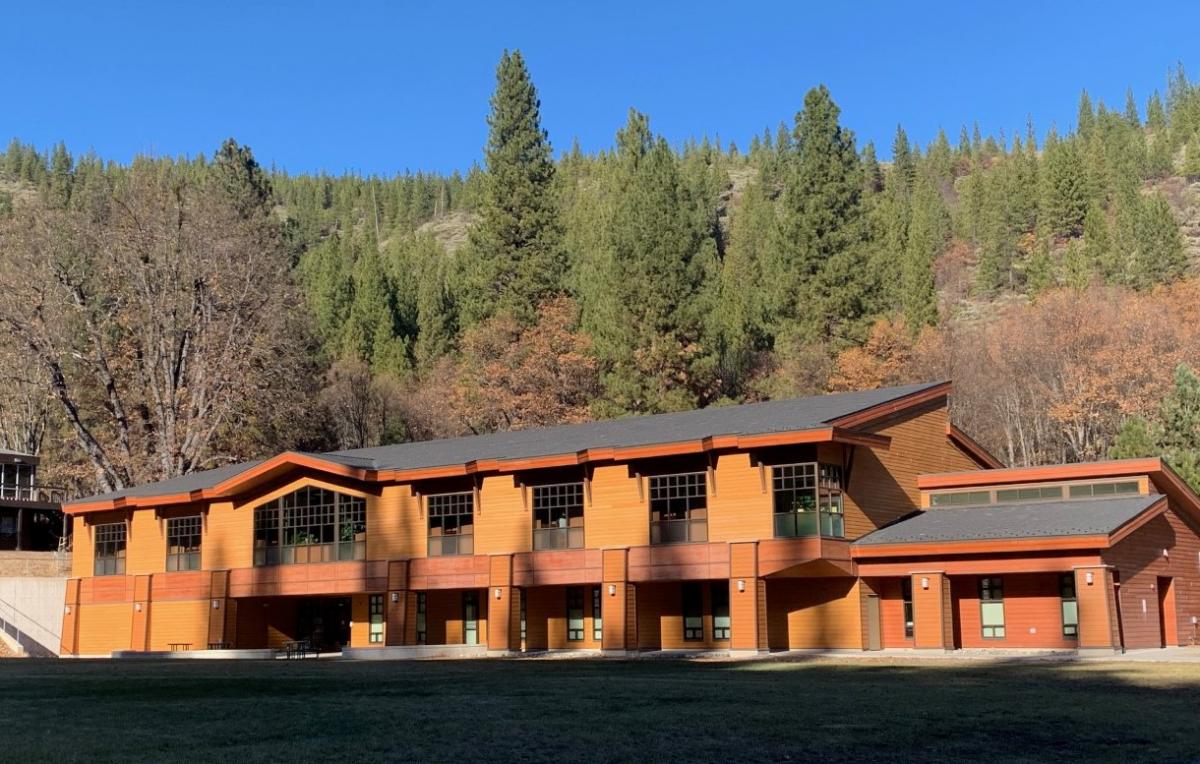
By Venice Lombardo and Darryl Swarm, Feather River College
Introduction
Feather River College (FRC), located in rural northeastern California, decided to open its campus during the Fall 2020 semester. This presented a number of challenges. This article will discuss the strategies the FRC Library employed to successfully reopen, the obstacles encountered along the way and the lessons learned, in hopes that other institutions will be more informed when considering reopening.
Initial Closure
FRC closed its campus when Governor Newsom issued a shelter in place order on March 19. The President’s staff created a tiered system for employees which determined who was allowed on campus during a COVID-19-related closure and under what circumstances. Library Director Darryl Swarm and Senior Library Assistant Venice Lombardo requested special permission according to the tiered system guidelines to return to campus in order to access needed physical and electronic documents. Lombardo worked with Desktop Support Specialist Mark Downey from the IT Department to set up remote access to the Library office computer and the college’s Enterprise Resource Planning/Student Information System.
Establishing Continuity of Service during Disruption
Library staff reacted quickly by developing some of FRC’s earliest guides for learning and teaching remotely. Staff had previous experience with campus disruptions, having built a guide to direct students and faculty to important resources in the wake of the 2018 Camp Fire. While the Library worked throughout the closure to improve its response, Spring Break in particular allowed us to develop a comprehensive and timely response prior to the resumption of classes as follows:
- Webpages (drafted in anticipation of a transition to online instruction):
- We created a For Students remote learning guide that:
- Promotes academic resources, including free access to e-textbooks; discounts at language-learning websites; a free transcription app and free access to Microsoft Office; and
- Promotes personal resources, including free media (e-books, e-audiobooks, music, films, etc.); parenting guides; wellness, exercise and stress management advice; and virtual tours and exhibits.
- We modified our existing For Faculty guide:
- Remote Teaching tab added and made the default landing page;
- Promotes the same academic resources as the For Students guide; and
- Also includes guidance on online course design and courseware.
- Circulation:
- All items on loan were renewed and due at the end of the semester.
- Library returns were accepted by mail with the postmark date considered the date of return, rather than the date of arrival.
- Communication:
- Google Voice numbers were created for each Library staff member.
- Other outreach:
- We replaced our usual physical book and film displays with online e-book “exhibits” centered on themes of common interest.
- We used our monthly newsletter to promote distance education resources and created an online archive for previous newsletter issues.
- Two Library staff members served as chat operators for the college’s new Chat feature.
Expectations for Reopening for Fall 2020
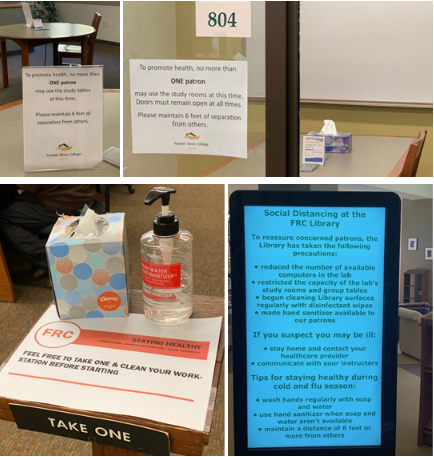
including capacity limits, health promotion
signage, social distancing, and sanitation measures.
While most courses were to be delivered online, athletes and students enrolled in hard-to-convert classes were expected on campus. Library staff were unsure what to anticipate for foot traffic, since on-campus students taking simultaneous online classes might converge on the Library for online class meetings. We wondered: would we have an influx of local and dormitory students eager to take advantage of in-person services; would there be a demand to speak face-to-face; with most students learning remotely, would in-person interactions last longer due to less “competition” for our attention?
It was also expected that access to college email accounts and the Library’s electronic collections, difficulties with courseware and obstacles to registration would be the most common issues.
While a local influx never materialized, with foot traffic reduced anywhere from 62%-82% during a typical week compared with Fall 2019, longer interactions did become more frequent, especially among less tech-savvy students who relied on the Library’s computer lab and technical assistance to complete their coursework.
Measures Taken to Reopen the Library Building for Fall 2020
Capacity, social distancing and hygiene considerations were put into place as early as February in anticipation of later disruptions, easing reopening efforts for the Fall. When County Public Health Agency officials toured our facility during the Summer Session, they recognized our ability to address their primary concerns and were pleased with the steps we had taken. These and other measures were carried forward through the Fall semester, including:
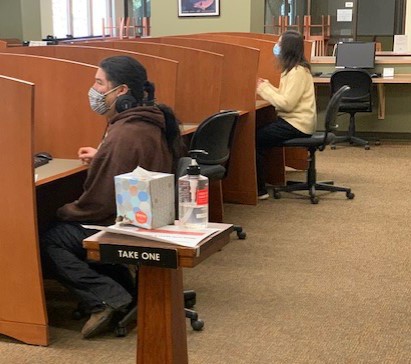
measures in the computer lab.
- Public health promotion:
- Library staff and student workers circulate throughout the Library looking for public health concerns, including social distancing, mask compliance, patron health status, identifying areas in need of sanitizing or clean up, etc.
- The Library has established an environment where student workers promote peer accountability.
- Capacity
- The number of available computer lab stations is reduced from 30 to 15.
- The group study table capacity is reduced from four to one.
- The group study room capacity is reduced from six to one and the door must remain open at all times.
- Hygiene:
- Hand sanitizer is available at the front desk, computer lab and building entrances.
- Sanitizing wipes, anti-viral tissues and disposable masks are available for patron and staff use at the front desk and/or computer lab.
- Schedule changes:
- We open a half hour later and close a half hour earlier for cleaning; and
- We close from 1:00pm-2:30pm daily for mandatory cleaning procedures by Library staff, our student worker and the deep cleaning done by Facilities.
- Deep cleaning:
- A Facilities staff member is scheduled to come every day during our closure with a fogging machine that sprays a fine mist of disinfectant throughout the Library.
- Library staff maintains a checklist of areas requiring regular disinfecting, such as door handles, desks, tables, chairs, countertops, computer stations, light switches and other frequently touched surfaces.
- Library staff have inquired with Facilities to ensure the fresh air intake of the building’s HVAC system is at its maximum.
- Circulation:
- Our physical collections are entirely closed stacks. Library staff retrieves physical items requested by patrons.
- Physical items are checked out for the entire semester.
- Physical items are quarantined for 14 days after return.
- Reserve textbooks are not available for checkout, but patrons can request that staff photocopy or scan <10%. Textbooks are also accessible through Student Services and the Bookstore.
- Periodicals are also not available for checkout, but patrons can request that staff photocopy or scan the desired article(s).
- A new partnership with Plumas County Public Library System now allows students without a local physical address to access their electronic collections, which include e-books, e-audiobooks, the New York Times online, a historical document database, online tutoring and job help, etc.
While many classes during the Fall remained online-only, a core group of students returned to campus for athletics, laboratories and hard-to-convert classes. After the Thanksgiving holiday, all classes switched to online-only and will remain so for the remainder of the semester.
Obstacles Encountered during Reopening
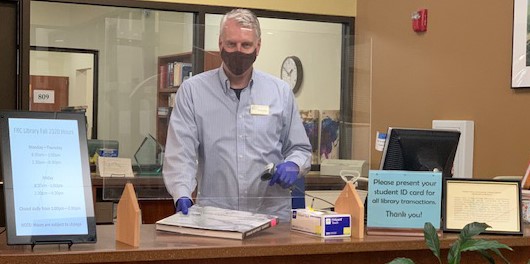
Effective communication with the college community remains a challenge. Even with notices on the Library’s website, our newsletter, email announcements and physical signage throughout the building, we do not always reach as many as we would like.
Additionally, reopening effectively involves cooperation with other departments. The Library is especially dependent on the IT Department to ensure remote access to our electronic collections and the Facilities Department for Personal Protective Equipment (PPE) and cleaning supplies. IT staff are not always available during Library hours and the Facilities Department sometimes encountered supply shortages. Staff in both departments are also often stretched thin attending to various issues on and off campus.
The Library is also in frequent dialog with Administration regarding implementation of appropriate measures, such as reduced hours. This means we are sometimes unable to answer patron inquiries until Administration has reached a final decision, telling patrons to “stay tuned” or “we’ll get back to you.”
Lessons Learned from Reopening
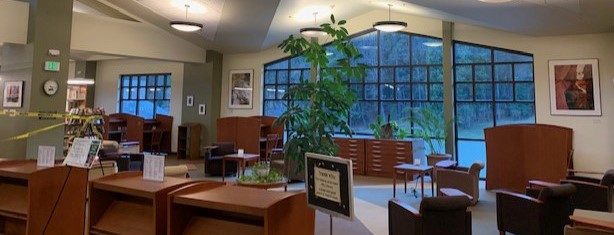
closed stacks and periodicals by request.
Flexibility is crucial. No matter how well thought-out your plans are and how thoroughly you’ve prepared, these situations will remain fluid and unpredictable. Be ready to change your plans at any time and communicate such news promptly with the rest of the college. Know who you need to collaborate with and keep in mind that others won’t always be able to respond immediately and may have different perspectives on how to approach a shared problem.
Conclusion
In conclusion, reopening an academic library can be done with reasonable confidence when appropriate measures are taken. Reopening is also made more successful by the measures taken during the closure to ensure a continuity of services. This prevents disruptions for students in their classes and means that patrons, regardless of whether the physical location is open, have access to what they need when they need it.
If a continuity of services is ensured during the closure, patrons won’t feel as if they’ve been missing out and submitting subpar coursework. They’ll view the reopening with optimism and confidence, rather than uncertainty.